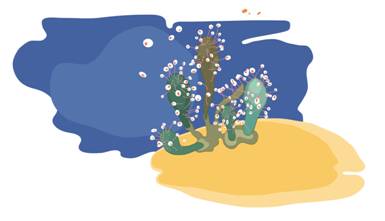Rebecca Agnes
dal 2/3/2006 al 25/4/2006
Segnalato da
2/3/2006
Rebecca Agnes
Galerie Davide Gallo, Berlin
In artist's works she invents fictional tales and unreal, but nevertheless infinitely possible places, and invites the viewer to participate in a journey into imaginary geographies. The language she uses to describe these worlds has a precise, almost scientific tone that recalls to the pages of old manuscripts.

Where pods grow before falling on earth
The Italian artist Rebecca Agnes recounts stories. In her works she invents
fictional tales and unreal, but nevertheless infinitely possible places, and
invites the viewer to participate in a journey into imaginary geographies.
The language she uses to describe these worlds has a precise, almost
scientific tone that recalls to the pages of old manuscripts.
The video A short trip in the other side of the galaxy, where pods grow
before falling on earth (2005/06) is, as its title suggests, a journey into
an unknown planet to discover how the pods - kind of vegetable organisms -
are born and grow. The world where the pods grow, is a sort of underwater
submarine reign. Here, amoeba-like creatures settle in the pods, plants
mature and flourish, spaceships and cities under geodesic glass domes
suddenly appear. Here everything evolves and moves; all is unstable and
precarious, so that we are always only treated to a short glance at what is
happening. As in every world, there are rules: These are finely and minutely
described in the lightbox series Galaxy, which accompanies the video. In
these lightboxes, all the species are analyzed and archived as if they were
part of a botanical or ethnographic encyclopaedia. All their movements,
differences, permutations, displacements and developments are catalogued; so
that by observing and studying the lightboxes we can understand how this
world functions.
Rebecca Agnes uses different approaches to build up her stories. Citta'
(Cities, 2003) consists of ten maps of unreal, hypothetical cities. They
reflect the personality and the dreams of the ten people to whom these are
maps dedicated and by whom they were inspired. Portraits through places,
drawn with an architectural computer program. In a second phase the “owner"
of each city intervenes by drawing directly on the map with a felt-pen
whatever they felt was missing. In Mappa (Map, 2002) the geography of the
world is subjected to a personal revision. Every place, city or continent
where Rebecca Agnes has never been or that she has never had an experience
of, is deleted from the map. The result is a fragmented but practised
geography that reduces the world into a self-portrait, where the only places
that remain are those which have been experienced directly, through Agnes’s
own travels, or indirectly - through books, stories, film, dreams, or
imagination. You couldn’t find, for instance, Sicily and Sardinia, but you
can see the region of Uqbar narrated by Borges.
Finally, stories are also narrated in Rebecca Agnes’s collaborative
embroidery works. She asks friends to make up stories and fix them by
drawing them on a white cloth that she later embroiders. Even if, in these
cases, Agnes gives precise and careful instructions, the result remains -
like in a scientific experiment - unknown until the very end.
All these works are defined by Agnes’s slowly patient approach. Even when
she uses a traditional medium such as embroidery, or an utterly modern one
like a computer animation program, the same delicate and refined attitude
towards narration and drawing can always be seen. (Roberta Tenconi)
Opening: Friday 2006, March 3rd, 18:00-21:00. The artist will be present. Followed by drinks
Galerie Davide Gallo
Linienstrasse 156 -Berlin



